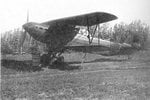Fokker C.X
The Fokker C.X was a biplane scout and light bomber designed in 1933. It had a crew of two (a pilot and an observer). It was originally designed for the Royal Dutch East Indies Army, in order to replace the Fokker C.V. Like all Fokker aircraft in that period, it was of mixed construction, with wooden wings and a welded frame covered with aluminium plates at the front of the aircraft and with linen at the back. The prototype was built in 1934 with a Rolls-Royce Kestrel V engine.
The East Indies Army ordered 13 C.Xs, but they were soon replaced in the scout/light bomber role by the American Martin B-10s. Until the Japanese attack on the Dutch East Indies in 1941, the C.X remained in use as a trainer and target tug. The Dutch Air Force ordered 16 C.Xs, and four more C.Xs with Kestrel IIS engines. These four were later re-equipped with Kestrel V engines, because the Kestrel IIS was not very reliable.
Like the D.XXI, the C.X was set to be produced under license by the Republicans. A pattern example was flown in Spain, and a second was flown with a Soviet M-100 engine. This is the only picture that is know to exist of a Fokker C.X in Spain. You wont find any other.
The Fokker C.X was a biplane scout and light bomber designed in 1933. It had a crew of two (a pilot and an observer). It was originally designed for the Royal Dutch East Indies Army, in order to replace the Fokker C.V. Like all Fokker aircraft in that period, it was of mixed construction, with wooden wings and a welded frame covered with aluminium plates at the front of the aircraft and with linen at the back. The prototype was built in 1934 with a Rolls-Royce Kestrel V engine.
The East Indies Army ordered 13 C.Xs, but they were soon replaced in the scout/light bomber role by the American Martin B-10s. Until the Japanese attack on the Dutch East Indies in 1941, the C.X remained in use as a trainer and target tug. The Dutch Air Force ordered 16 C.Xs, and four more C.Xs with Kestrel IIS engines. These four were later re-equipped with Kestrel V engines, because the Kestrel IIS was not very reliable.
Like the D.XXI, the C.X was set to be produced under license by the Republicans. A pattern example was flown in Spain, and a second was flown with a Soviet M-100 engine. This is the only picture that is know to exist of a Fokker C.X in Spain. You wont find any other.





